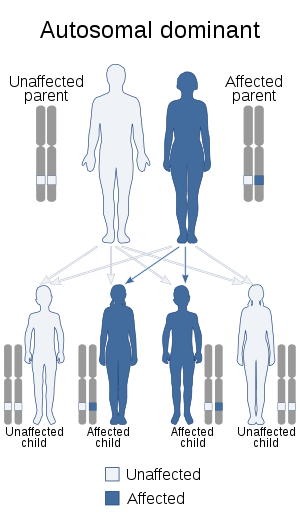Hereditary neuralgic amyotrophy
Hereditary neuralgic amyotrophy (HNA) is a neuralgic disorder that is characterized by nerve damage and muscle atrophy, preceded by severe pain.[1] In about half of the cases it is associated with a mutation of the SEPT9 gene (17q25). While not much is known about this disorder, it has been characterized to be similar to Parsonage-Turner syndrome in prognosis.[2]
| Hereditary neuralgic amyotrophy | |
|---|---|
 | |
| This condition is inherited in an autosomal dominant manner | |
| Specialty | Neurology |
Symptoms
Symptoms of HNA may include pain in the back, neck, arms, or shoulders, nerve pulls in the arms or back, muscular atrophy, and weakness.[2]
Presentation
HNA is an episodic disorder; it is characterized by episodes generally lasting 1–6 weeks. During an episode, the nerves of the brachial plexus are targeted by the body as antigens, and the body's immune system begins to degenerate the nerves of the brachial plexus. The exact order or location of the nerve degeneration cannot be predicted before an episode. Other areas of the nervous system that have been affected are the phrenic nerves and the recurrent laryngeal. As the nerves lose function, the muscles associated with those nerves begin to atrophy. In brachial plexus degeneration, atrophy may occur in the deltoid muscles. In phrenic nerve degeneration, the diaphragm may be affected. In this case, breathing can be impaired due to a lack of muscle control of the diaphragm. If the recurrent larangyl nerve is targeted, the pharynx will begin to atrophy and voice function may be lost.[2]
Diagnosis
Treatment
The severe pain of HNA can be controlled with an anti-inflammatory drug such as prednisone, although it is unknown whether these anti-inflammatory drugs actually slow or stop the nerve degeneration process.
Nerve regeneration after an episode is normal, and in less severe cases a full recovery of the nerves and muscles can be expected. However, in a severe case permanent nerve damage and muscle loss may occur.[2]
See also
- Parsonage Turner Syndrome, known as Neuralgic Amyotrophy
References
- van Alfen N (June 2007). "The neuralgic amyotrophy consultation". J. Neurol. 254 (6): 695–704. doi:10.1007/s00415-006-0246-4. PMC 2780663. PMID 17446996.
- Online Mendelian Inheritance in Man (OMIM): Amyotrophy, Hereditary Neuralgic; Hna - 162100
External links
| Classification | |
|---|---|
| External resources |
- GeneReview/NIH/UW entry on Hereditary Neuralgic Amyotrophy
- Neuralgic Amyotrophy: idiopathic and hereditary form